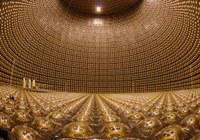When we look out at our universe of planets, stars and galaxies, we are looking at a universe that should not exist.
According to our understanding of how the cosmos began, equal amounts of matter and anti-matter were created in the Big Bang nearly 14 billion years ago. For every proton there was an anti-proton; for every neutron there was an anti-neutron; and so on.
And — just as Star Trek taught us — all that matter and anti-matter should have completely self-annihilated leaving empty space filled with nothing but photons.
For decades, physicists have been searching for an explanation for why that didn’t happen and why instead we live in a universe dominated by matter with next to no anti-matter. In other words, why are there galaxies, stars, planets and people when there should be nothing?
One possible explanation was found in a difference — an asymmetry — between quarks and anti-quarks, the fundamental subatomic particles that are the building blocks of protons and neutrons. As a result of such an asymmetry, one quark in every billion quark-antiquark pairs avoided annihilation.
However, this quark/anti-quark asymmetry isn't large enough to account for all the matter we see today.
Why is the universe the way it is?
In a paper published in the journal Nature earlier this year, a team of physicists reported the best evidence yet for an asymmetry between neutrinos and anti-neutrinos that could explain our matter-dominated universe.
The team includes Professor Emeritus John Martin and PhD student Trevor Towstego.
Read the full article here:
https://www.artsci.utoronto.ca/news/why-isnt-there-nothing-universe-physicists-are-one-step-closer-answer

